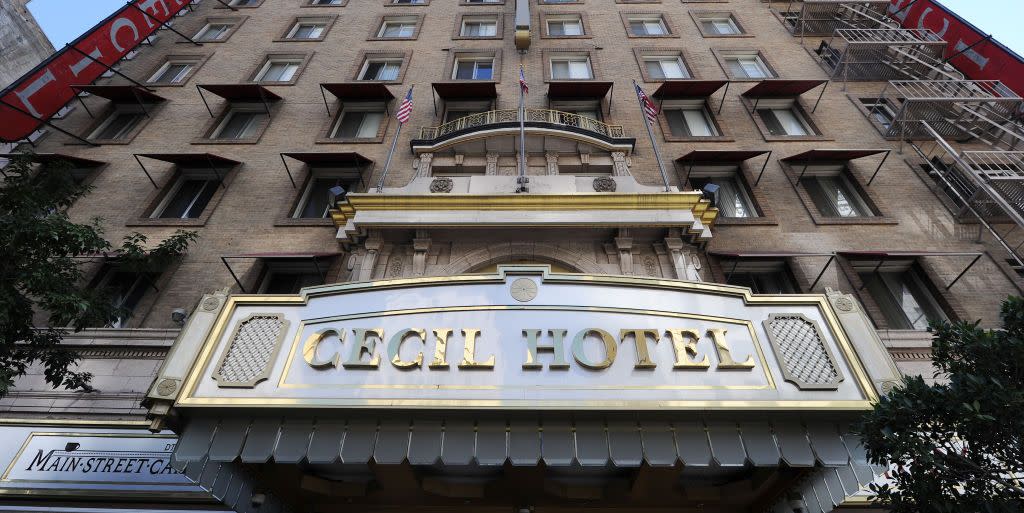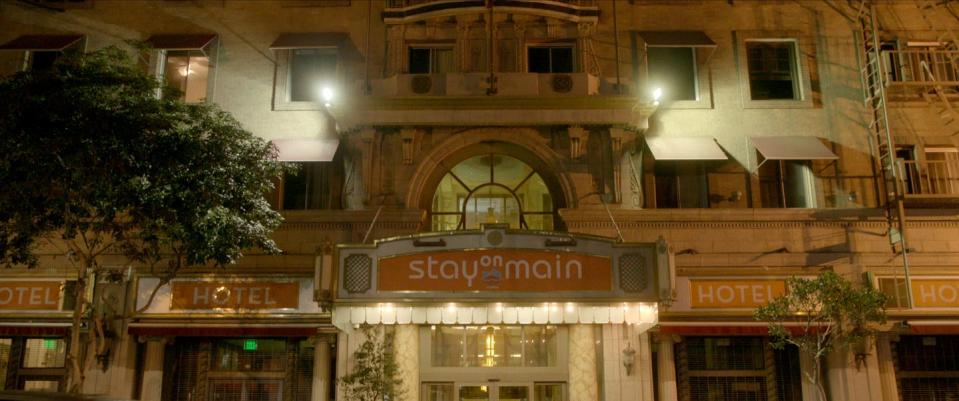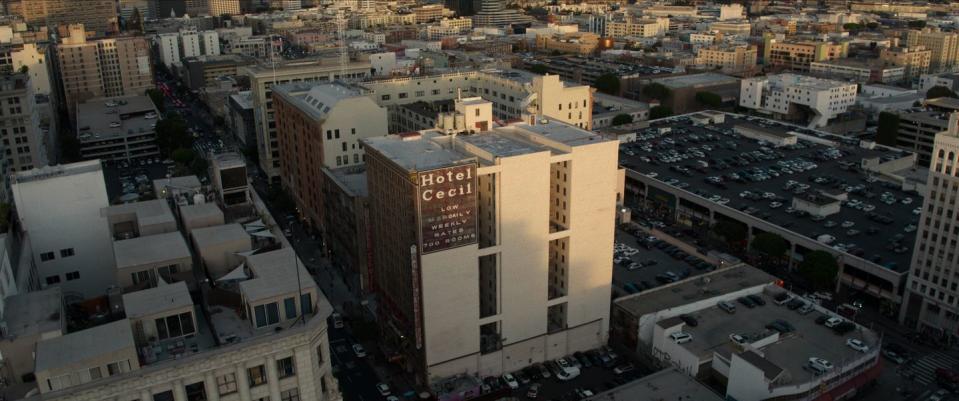How Downtown L.A.’s Cecil Hotel Went From Lively Destination To “Hell On Earth”

To walk around downtown Los Angeles is to see ghosts. Even on a crisp, bright Sunday morning, they’re impossible to miss. The ghost of a thriving financial district, once dubbed "the Wall Street of the West," now abandoned. The ghost of a beloved streetcar system that was ripped out in the 1960s, leaving L.A. dependent on congested freeways. And if you believe in this sort of thing, there are also the ghosts of all those who’ve suffered and died at the Hotel Cecil, whose checkered history is the subject of the new Netflix documentary Crime Scene: Vanishing at the Cecil Hotel.
The Cecil has seen more than its share of violence over the years: at least 16 people have died there, and it has been the location of countless other brutal crimes. Serial killer Richard Ramirez even called it home during much of his 1985 murder spree. Most recently, 21-year-old Canadian student Elisa Lam died during her stay under mysterious, disturbing circumstances. The hotel closed its doors four years ago, following an eventful decade of attempted reinvention; aware of the Cecil’s reputation, its new owners had tried to rebrand it as a hip, low-budget hostel called Stay On Main, an effort that stumbled in 2013 when Lam’s body was found in a rooftop water tank.
Today, the place has an eerie and discordant vibe. Its modern “Stay On Main” branding sits awkwardly alongside the ornate 1920s architecture of the building, vivid orange clashing with gold trim. But if you peer through the glass, you can still see the opulent lobby, all marble and terrazzo flooring and wrought-iron lamps. How did this elegantly designed hotel go from being a lively, desirable destination, to what one detective quoted in Netflix’s documentary described as “hell on earth”?

To understand what happened to the Cecil, you first have to understand what happened to Los Angeles. Though now known as a place where you can’t survive without a car, L.A. once boasted a sprawling public transit system that criss-crossed the entire city. In the early 20th century it was the largest electric railway system in the world. Proximity to the railway lines was central to the Cecil's appeal when it opened its doors in 1927—its Main Street destination was then at the beating heart of the city, surrounded by theaters, restaurants, shopping, and the Spring Street Financial District. Designed by local architect Loy Lester Smith, and named after the prominent hotel of the same name in London, the Cecil catered to business travelers and tourists who wanted to be where the action was.
Soon, though, the action in downtown took a turn. The Great Depression hit the area hard, as did the rise of the suburbs and the birth of L.A.’s freeway system. “After World War II, people wanted more space, they wanted a more suburban environment,” historian Kim Cooper explains. Once the freeways were built in the early 1950s, people began settling further away from the core of the city, leaving downtown increasingly unoccupied. Entire buildings sat vacant, with restaurants, bars, or jewelry stores doing business on the ground floor, and six stories sitting empty above.

By 1960, L.A.'s streetcar system was torn out, putting a final nail in the coffin of downtown as any kind of city center. Walking around the neighborhood, you can see the anchor hooks on the corners of buildings where the streetcar cables used to connect, the scars of a wound from which the neighborhood has never recovered. As the population of Los Angeles surged during the 1960s, downtown was trapped in amber, an increasingly edgy ghost town.
“It became a lawless kind of place, and a place for people who couldn’t—or didn’t want to—live in any other kind of environment,” Cooper continues. And even within downtown, their options were dwindling. According to the L.A. Chamber of Commerce, roughly half of downtown L.A.’s small hotels were demolished during the 1960s (an unintended consequence of stricter building codes), which “contributed to the displacement of a significant number of extremely low-income, substance dependent and/or mentally unstable persons.”
Many of these people ended up on Skid Row, just yards from the Cecil. Crime became rampant in and around the hotel; detectives in the Netflix series noted that the LAPD would routinely respond to multiple calls a day from the hotel. And so, no longer able to attract business travelers or tourists, hotels like the Cecil began offering single-room occupancy accommodations, where down-on-their-luck tenants would rent solo rooms with shared bathrooms, often on a long-term basis.

But in 2007, as downtown L.A. was rapidly gentrifying, new owners set out to turn the Cecil around. “It didn't take long to realize that the place was different,” says Amy Price, who was hired at the hotel's general manager in 2007. Price had never worked in the hotel industry before taking the job, and had what one can only imagine was a baptism by fire. “Talking with the hotel employees, many of whom had been there for years, I quickly realized that there were some things going on that were completely new to me. We were faced with a lot, there is no question. But we were running a legitimate business, and the people that worked there cared. We showed up every day to do a job and survive, and we did our best.”
One major challenge the hotel’s new owners faced was that it was a protected low-income building, with a number of long-term residents who could not simply be evicted to make space for more guest rooms. “No one told them that,” Cooper says, incredulously. “No one at the city said, ‘Hey, guys, this is a protected low income building. Everyone who lives here has rights, and you can't just throw them out on the street and start renting the rooms out by the night.’” The Stay On Main rebranding was their solution to this problem, designating certain floors of the building for long-term residents, and others for hip hostel-style accommodations geared towards young tourists on a budget.
“It was nice branding,” Cooper says with a shrug. “If you don’t know Skid Row, you probably think you do want to stay on Main!” She and her husband, who lead historic tours of the neighborhood through their company Esotouric, were baffled when they noticed the new clientele. “We started seeing all these young people, mostly girls, with their wheeled suitcases, and were like, what is going on? Because that part of Main Street, you're not used to seeing tourists.”
One of these girls was Elisa Lam, who booked a few nights at the Cecil in 2013 as part of a solo vacation along the West Coast. Given the high crime rate in the surrounding area, foul play was initially suspected after Lam's body was found in the water tank, several weeks after her disappearance. But ultimately, as the Netflix documentary explores, Lam’s death seems to have been a tragic accident caused by a psychotic episode. Still, conspiracy theories and ghost stories abound.

“I do believe in ghosts,” Price says, when I ask her about the mythology surrounding the hotel. “But I certainly don’t believe that ghosts and goblins were running the show at the Cecil, in any way. I really do believe that it’s circumstantial. It’s the area. Things occur there that make it easier for people to wrap it up and say ‘Oh, well, it’s just a dark place.’ I don’t believe that.”
Cooper, meanwhile, has spent enough time studying history to develop a keen awareness of how the past can manifest itself in physical spaces—it's not ghosts, necessarily, so much as a shift in energy. “I do really have the sense that older places have this almost subsonic vibration, if you're quiet and you're sensitive to it. You can just feel the presence of those who've come before, and it's not scary, and it isn't dark, particularly.” The Cecil, like much of downtown Los Angeles, is a place where a lot of people have done a lot of suffering, and that has a weight that can’t be fully explained. “You have to respect it,” she continues. “You have to take it in and say, 'this place has seen things, and it can’t tell us what it’s seen, but the least we can do is acknowledge it.'” That heaviness is evident in reviews from people who stayed at the hotel while it was still in operation—a representative Yelp review read: "The Cecil Hotel is where dreams go to die."
The Cecil is probably not haunted, but that doesn’t mean there are no modern day horror stories to tell about it. Here’s one: almost all 600 of its rooms are currently sitting vacant, at a time when people are dying in record numbers on the streets of L.A. On the sidewalk just across Main Street, a new homeless encampment has sprung up over the past few months, a hallmark of just how hard the pandemic has hit an already challenged neighborhood.
In 2014, the Cecil was bought by Richard Born, whose portfolio of New York hotels includes the Bowery and the Greenwich. In 2016, operator Simon Baron Development announced plans for a major renovation, which would involve turning the Cecil into a blend of boutique hotel rooms and affordable housing. As of 2019, Curbed LA reported that the renovation was scheduled to be completed by October of 2021, but no work has yet begun. It’s unclear what the timeline is on any kind of reopening, and just a handful of long-term tenants remain.
“This notion of splitting the building in half, it seems like there's no urgency about it,” Cooper says, with palpable frustration. “They could potentially take all the hotel rooms right now, just as they are and put people who are living on the street in them under Project Room Key. And FEMA has said that they will pay 100% of that money back to the city of L.A., so it's not even like the city has to pay for it.”
Once you discover this, you can’t unsee it. Walking around downtown L.A., taking in its tent cities and its numerous vacant windows, it all begins to feel like a grim joke. The Cecil is not the only building sitting empty in this area, and meanwhile the streets are getting more and more crowded. “The city is not actually doing the business of protecting Angelenos,” Cooper concludes. “It's very, very hard to watch.” So, too, is Crime Scene, but at times it's nearly impossible to look away.
Watch the trailer:
You Might Also Like

